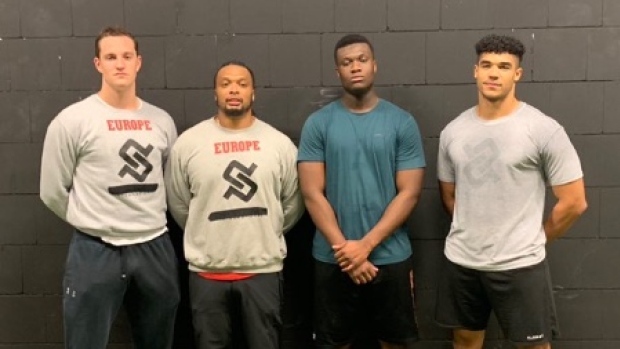Mar 28, 2019
Former Bomber Collier helping cultivate international football talent
Onetime CFLer says league’s new global vision will be aided by emerging international football talent already making its way to NCAA Division I schools, Dave Naylor writes.
By Dave Naylor

When Brandon Collier went to play football in Frankfurt, Germany, after being cut by the Winnipeg Blue Bombers in 2013, he wasn’t sure what to expect.
The former University of Massachusetts Minuteman had spent time in the both the CFL and NFL and was looking for a new football adventure. What he found when he got to Europe surprised him.
“We all think North America is the only place for football, but I was definitely shocked by the size of the players and their athletic ability,” said Collier. “I came straight from Canada to play over here and said, ‘Some of these players should be starting in Canada.’”
Six years later, Collier’s company, Premier Prospects International, has become an important player in the development of international football players. It has helped 40 players land NCAA Division I scholarships, including its first quarterback – Luke Wentz – who will begin his freshman year this fall at the University of Virginia.
Collier says there are more players on the way from all over Europe – a lot more.
“I’ve been working with kids between 15 and 20 years old and the talent is there and it’s only getting better,” said Collier, who is based in Frankfurt. “For example, when Temple plays Rutgers this year there’s going to be three Swedish kids on each side of the field…in five years it’s going to be amazing.”

Not all that long ago, Collier was getting cold stares or smirks from college coaches when he suggested they look at European prospects. But that has changed quickly, to the point that schools are now pursuing him.
“At first the coaches would say, ‘Do they play football over there?’ It was a joke to them,” Collier said. “But then when I brought players to America and they see the size and athleticism and that these kids were the best kids at these camps the conversation changed to, ‘How do we get these kids?’ I don’t really have to sell the kids anymore.
“My phone never stops ringing…I’ve gotten calls from Alabama and Clemson about kids, so they are aware of the European talent. In the beginning, getting to small school was a dream, but now they see kids going to Penn State, Notre Dame and Michigan, so it’s more of a goal for the kids rather than a dream.”
Along with inviting college coaches and scouts to his camps in Europe, Collier runs an annual late-spring, early-summer tour that brings the best international players to America.
Last summer, he brought 25 players on a tour of U.S. schools, 18 of whom landed NCAA Division I scholarships.
This May and June he’s bringing 50 players to the U.S., including four from Africa and two from Australia as he looks to expand his recruitment beyond Europe.
All of that is good news for the CFL as it pursues an international strategy based on being able to land the best players from beyond North America to create new audiences. That business model represents an outside-the-box approach and one the league is determined to pursue.
Any chance of success, however, is going to require some elite international talent, which Collier maintains is on the way.
“Most of the kids at college are freshmen and sophomores so in two years these kids are going to be really good,” Collier said. “If the Canadian league keeps this rolling, with all these kids going to college, they’re not all going to the NFL and they are going to be very talented. I think in the next three to five years this can help the Canadian Football League find some big-time international players. I think it will be good for the league and grow the Canadian football fan base worldwide.”
Collier followed the results of the 18 European players who attended the recent CFL combine in Toronto.
He believes that the performance of teenage players in Europe will continue to rise as they are exposed to better competition and coaching while setting their sights on U.S. college scholarships.
“The 18 kids definitely had a good showing, but I can tell you that if the CFL continues to look for kids they could find 20 to 30 players that could really play in that league and have an impact,” Collier said.


